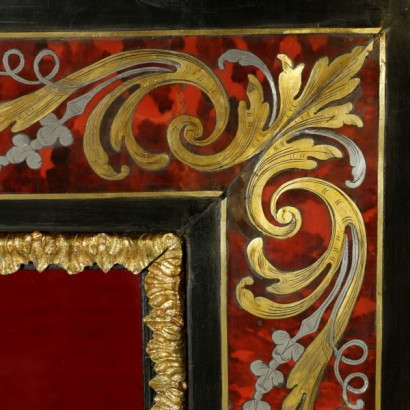“
Ludwig II, the “King Moon” lover of the furnishings in the Louis XIV style
Read more „
Impressive 19th Century Louis XIV Sideboard - In the style of Louis XIV
Features
In the style of Louis XIV
Style: Louis XIV Revival
Age: 19th Century / 1801 - 1900
Year: 1850 ca.
Origin: Germany
Main essence: Ebony
Material: Ebony Veneer
Description
Impressive 19th Century Louis XIV sideboard made up of two side doors with glasses and a central door with inlaid panel. The whole cabinet is ebony veneered with turtle inserts engraved with pewter and brass. The central door, the richest panel, is embellished with important chiseled and golden bronzes; A lion head with acanthus leaf wings rests on a base with volutes and profile masks ending in a 'lambrecchino' curtain; Underneath these bronzes a gorgeous mask dominates a frame with lateral goat heads and leopard paws. Four monumental brass and bronze columns, resting and ending with bronze capitals divide the architecture of the item. Brass covered top edge. Under the top, a frame with subsequent bronze leaves, with the central door frame and those between the columns, increases the contrast of gold with the ebony of the brass threads. In the plinths of the base under which the feet stand, the golden bronze lion heads are housed. Six turned feet with golden bronze collar hold it all. Double chiseled and golden bronze door locks, inside red velvet. The key features a chiseled handle with the patron's coat of arms, quadripartite coat of arms with two lions and two squares with diamonds, surmounted by an imperial crown recognizable in the heraldry of the elector of Bavaria. Manufactured in Germany, circa 1850.
Product Condition:
Good condition. Wear consistent with age and use. Any damage or loss is displayed as completely as possible in the pictures.
Dimensions (cm):
Height: 137,5
Width: 232,5
Depth: 55
Additional Information
Notes historical bibliographic
The furniture presented here suggests, for its monumentality the place in a great hall from the palace. Originally there were certainly two or four, a sister was sold on the antiquities market in london in 2016. The construction and the taste of Louis XIV, virtually a copy of the furniture Boulle, we do not date to the middle of the century, or shortly before, when the revival of the Sun king is at its peak and not yet tainted by the various influences of styles which characterize the productions of the epoch Napoleon III. And' the handle of the key that makes us assume that the furniture was purchased to decorate the castles of the Bavarian King, Ludwig II of Wittelsbach, who reigned from 1864 to 1886. Ludwig was known as an eccentric whose legacy is intertwined with the history of art and architecture, he commissioned the construction of several extravagant castles, fairy-tale, often with the furnishings in the taste of Louis XIV, which are used primarily for the Linderhof palace; inside the palace iconography reflects the charm of Ludovico for the Ancient Regime, the French. He believed, indeed, the "King Moon", in analogy with the "Sun King" Louis XIV of France.
Style: Louis XIV Revival
Ripresa stilistica, del 900, delle forme proprie dello stile Luigi XIV (1650-1720)
Age: 19th Century / 1801 - 1900
19th Century / 1801 - 1900
Main essence: Ebony
Without any doubt it is one of the most precious and appreciated essences ever. Very hard and resistant, it is pleasant to the touch thanks to its smoothness, it is a wood with a typical black color. Being very rare it was traded as a precious metal and frequently forged. Because of its hardness, it is very difficult to work, which is why the term cabinetmaker, which indicates the very skilled craftsman in fine carpentry works, derives from this very essence. In modern times, it was introduced by the Flemings and Germans and immediately enjoyed success with the French. The golden period for Ebony was the Baroque, especially in the Boulle style workings. In general it is widely used in inlays, but also for furniture upholstery, for contrasting effects alongside brass, bronze and tortoiseshell.
Material: Ebony Veneer




















































